Digital Marketing vs Traditional Marketing: Which Should You Choose?

Behind the doors of a successful business lies effective marketing efforts; be it digitally or traditionally.
Over the past three decades, there have been endless debates over whether Digital or Traditional Marketing is better. Some would even say that one is more superior than the other.
Digital marketing and traditional marketing are two distinct channels businesses use to reach their target audience and promote their products or services. While both have their own unique set of advantages and disadvantages, it’s important for businesses to understand the differences between the two and how they can be effectively utilised to achieve their marketing goals.
As we bring you through the definitions, benefits, as well as the pros and cons of each of the marketing channels, you’ll be able to find out which method of marketing would be best suited for your organisation.
What is Digital Marketing?

First introduced in the 1990s, Digital Marketing is defined as marketing efforts that use electronic devices or the internet to connect with customers.
This form of marketing relies heavily on data as strategies are often based on the insights extracted from big data analysis. Through the use of sophisticated tracking and targeting tools, digital marketing enables companies to successfully target particular demographics and reach a larger audience. On top of that, it can also help in anticipating future behaviours and a better insight into their audience and marketing activities.
Not only does digital marketing ameliorate the convenience and accessibility of information; it also addresses a consumer’s pain-points and needs.
Common marketing tactics include Search Engine Optimisation (SEO), Social Media Marketing, Email Marketing, Pay-per-Click (PPC) Advertising, and Content Marketing.
Digital Marketing can be done through multiple platforms. Some examples include:
- Social Media
- Websites
- Digital Advertising
- Search Engine Optimization
- Blogging Sites and Blog Partnerships
What is Traditional Marketing?

Traditional marketing refers to marketing efforts that do not utilise electronic devices or the internet.
The most distinct difference between traditional and digital marketing would be the analysis and evaluation of marketing campaigns. To determine which channels are suitable for a non-digital campaign, a pre-campaign analysis and research must be executed.
Digital campaigns, on the other hand, are one step ahead as its ability to evaluate a campaign is better. It also takes advantage of the engagement and action metrics to do a user analysis and a mid and post-campaign performance analysis.
While traditional marketing can still be effective, it tends to be more expensive and less targeted than digital marketing.
Common traditional marketing tactics include:
- Billboards
- TV Commercials
- Print Advertisements
- Radio
- Newspaper Ads
- Telemarketing
- Direct Mail
Pros and Cons of Digital Marketing
In 2022, 4.74 billion people use social media and users spend an average of 150 minutes solely on social networking every day. This has led to the rise of digital marketing as it’s increasingly prevalent among businesses in this day and age.
Research done by Gartner showed that more than half of digital spend is allocated to paid channels.
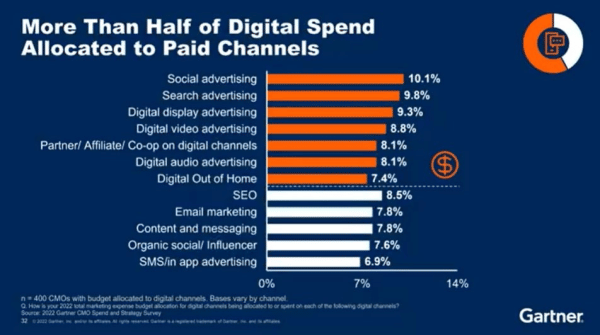
However, survey has also shown that the proportion of digital and offline expenditure has changed to a more equitable mix as people are engaging more at events and in person after two years of digital spending nearing 70% of marketing expenses.
While both traditional marketing and digital marketing have proven to still be effective, both have their pros and cons. Let’s dive deeper into them.
Pros of Digital Marketing
Greater Engagements
Digital Marketing allows for greater engagement with consumers. With traditional marketing methods, such as print ads and TV commercials, businesses have limited opportunities to interact with their audience. Digital marketing, on the other hand, offers a variety of channels and tools that allow businesses to connect with consumers in real-time and build long-term relationships.
One way that digital marketing allows for greater engagement is through the use of social media platforms. Social media platforms such as Facebook, Instagram, and Twitter allow businesses to create profiles, post updates, and engage with their audience through likes, comments, and direct messages. This allows businesses to build a community of loyal followers and create a two-way conversation with their target audience.
Another way that digital marketing allows for greater engagement is through email marketing. Email marketing allows businesses to send targeted messages to specific groups of consumers, and allows consumers to interact with the business through clicks, opens, and conversions. This allows businesses to track the effectiveness of their campaigns and make adjustments to improve their results.
Businesses can engage with consumers in a more personalised and targeted way. By utilising the various channels of digital marketing, businesses can build long-term relationships with their target audience and create a more meaningful connection with their customers.
Ability to Measure Campaigns
Businesses can track the effectiveness of their campaigns in real time, making it easy to make adjustments and optimise their strategies. With the variety of tools and platforms readily available, businesses can track the performance of their campaigns and measure their success. An in-depth level tracking of campaigns is achievable compared to traditional marketing as it has the means to segment through demographics and provides insights into the various campaigns.
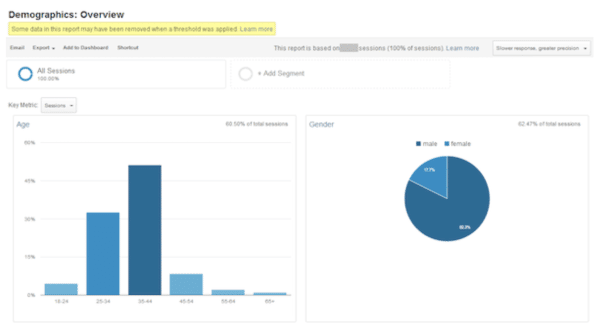
A demographic overview of the visitors to a site by Search Engine Watch.
One way that businesses can measure the effectiveness of their digital marketing campaigns is through the use of tracking and analytics tools. These tools, such as Google Analytics, allow businesses to track the number of website visits, clicks, and conversions generated by their campaigns. This allows businesses to see how their campaigns are performing and make adjustments to improve their results.
Another way that businesses can measure the effectiveness of their digital marketing campaigns is through the use of A/B testing. A/B testing allows businesses to compare the performance of two different versions of a campaign and determine which version is more effective. This allows businesses to optimise their campaigns and improve their results.
By using tracking and analytics tools and conducting A/B testing, businesses can optimise their campaigns and improve their return on investment. This allows businesses to make informed decisions about their marketing efforts, allocate resources and target specific audiences more effectively.
Target Your Market More Effectively
Another advantage of digital marketing is the ability to target specific demographics and reach consumers at different stages of the customer journey. With advanced targeting tools, businesses can reach specific groups of consumers based on factors such as age, location, and interests. This allows businesses to tailor their marketing messages to specific audiences and increase the likelihood of conversion.
One way that businesses can target their market more effectively with digital marketing is through the use of search engine optimisation (SEO). SEO involves optimising a website’s content and structure to make it more visible to search engines and improve its ranking in search results. By using targeted keywords and creating high-quality content, businesses can improve their visibility in search results and attract more qualified traffic to their website.
Another way that businesses can target their market more effectively with digital marketing is through the use of social media marketing. Social media platforms such as Facebook and Instagram offer a variety of targeting options that allow businesses to reach specific groups of users based on factors such as age, location, interests, and behaviour. This allows businesses to tailor their marketing messages to specific audiences and increase the likelihood of conversion.
Detailed Targeting on Facebook Ads
An example of how one can target their audiences through their demographics, interests, and behaviours would be through detailed targeting on Facebook Ads.
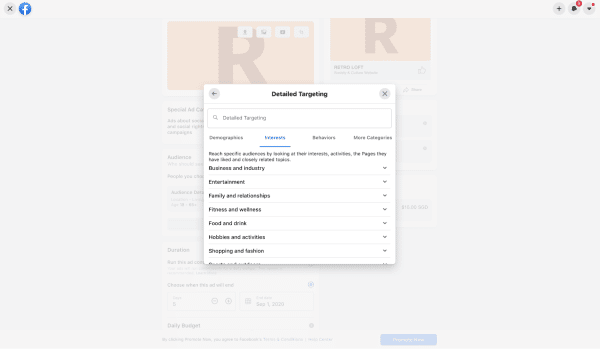
The ‘Detailed Targeting’ feature on Facebook Ads
Taking the screengrab as an example, if a brand is looking to sell running shoes, they can target their consumers through interest targeting.
Under the ‘Fitness and wellness’ section in the ‘interests’ category, the brand would be able to choose to target people who are interested in running and therefore offer them running shoes through a Facebook Ad.
Lookalike Audiences on Facebook Ads
Within Facebook Ads Manager lies a feature called ‘lookalike audiences’. This feature allows your adverts to be seen by new people who are more likely to be interested in your company because they have traits in common with your current clients.
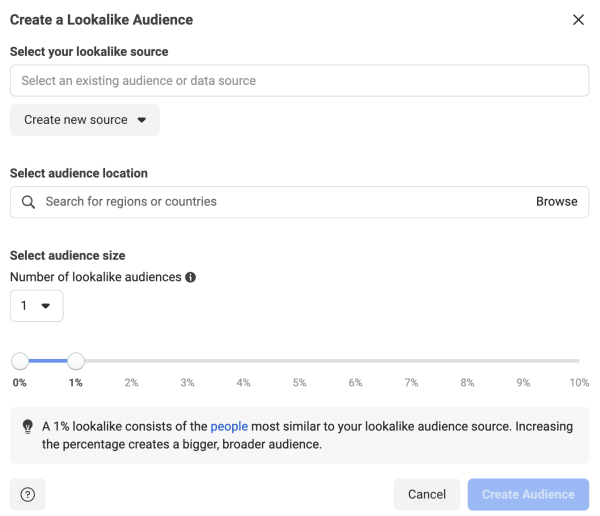
A screengrab of the ‘Lookalike Audience’ feature on Facebook Ads Manager
This feature helps you to focus your outreach on the right people who are highly likely to respond to your ads. You can create this by selecting an existing audience as your data source, selecting the location you want to target and and the percentage of similarity to your audience source. Facebook would then leverage on its massive user database to find users with similar interests or demographics as the brand’s existing audience. Facebook would thereafter deliver the ad to the new audience.
The ability to target specific demographics and reach consumers at different stages of the customer journey is a major advantage of digital marketing and helps improve the chances of success.
Greater Outreach
One of the major advantages of digital marketing is the ability to reach a wider audience and expand the reach of a business. You are no longer limited to specific geographic areas and reach but can expand your outreach to a global audience.
Through the use of social media platforms such as Facebook, Instagram, and Twitter you can have a global reach and connect with consumers around the world. By creating profiles and posting updates, businesses can build a community of followers.
Another way that digital marketing allows for greater outreach is through the use of pay-per-click (PPC) advertising. PPC advertising allows businesses to place ads on search engine results pages and pay only when a user clicks on the ad. This allows businesses to target specific keywords and reach users who are actively searching for the products or services they offer.
Facebook Ads for instance helps to reach out to the masses while targeting the right people. Not only can one target audiences based on their interests, demographics, and behaviours through detailed targeting; they can also target them based on their geographic location.
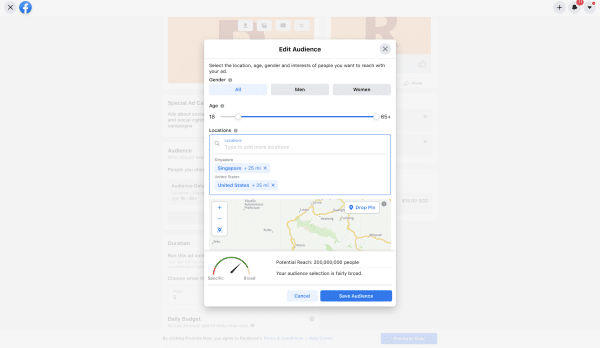
A screengrab of ‘Edit Audience’ on Facebook Ads.
Costs Efficiency
One of the major advantages of digital marketing is the ability to reach a large audience at a relatively low cost. With digital marketing, businesses can reach potential customers through a variety of channels, including social media, search engines, and email, at a fraction of the cost of traditional marketing efforts.
Small businesses and start-ups need many marketing activities to raise awareness for their brand but tend to have smaller marketing budgets. Hence, traditional marketing may be an expensive option.
There’s a wide variety of free digital marketing tools available — Social Media platforms like Facebook, Instagram, Twitter and YouTube, Email, Search Engine Optimisation, as well as blogging sites like WordPress and Blogger.
Using social media platforms as an advertising tool is often more affordable than traditional forms of advertising and allows businesses to reach a large audience for a relatively low cost. Besides that, by using pay-per-click (PPC) advertising, businesses can place ads on search engine results pages and pay only when a user clicks on the ad. This allows businesses to control their advertising budget and pay only for the traffic they receive.
Compared to billboards and print media, the paid ads, websites, and mobile ads are undisputedly more cost-effective and can help achieve your marketing goals without breaking the bank.
Cons of Digital Marketing
Sponsored Ads Can Be Intrusive
One of the potential downsides of digital marketing is that sponsored ads can be intrusive. With the rise of ad-blocking software and the increasing use of mobile devices, businesses are constantly looking for new ways to reach their target audience. This has led to the proliferation of sponsored ads on websites, social media platforms, and even in apps.
While sponsored ads can be an effective way for businesses to reach their target audience, they can also be intrusive and annoying for consumers. Many people find pop-up ads, auto-play video ads, and ads that take up the entire screen to be disruptive and annoying. This can lead to a negative impression of the business and decrease the likelihood that the consumer will engage with the ad or visit the business’s website.
It’s important for businesses to be mindful of how they are using them. You should aim to create ads that are relevant and useful for your target audience, rather than being intrusive or deceptive.
Ads are Less Permanent Compared to Traditional Ads
Another potential disadvantage of digital marketing is that ads are less permanent compared to traditional ads. With traditional advertising methods, such as print ads, billboards, and TV commercials, the message is delivered to the audience and remains in place for a specific period of time. This allows the business to reach a wide audience and have a lasting impact on potential customers.
On the other hand, digital ads are often ephemeral, appearing on a website or social media platform for a short period of time before disappearing. While digital ads can be targeted to specific demographics and can be more easily tracked and measured, they may not have the same level of impact as traditional ads.
One reason for this is that digital ads can be easily overlooked or ignored. With the rapid increase of ads on the internet and social media, it’s easy for consumers to become “ad blind” and tune out sponsored content. This means that even if a business is reaching its target audience through digital ads, it may not be having the desired impact. Additionally, digital ads are subject to the algorithms and policies of the platforms on which they appear.
Ever-changing Technology
One of the main challenges is the constantly evolving nature of the digital landscape. As technology and consumer behaviour change, businesses must constantly adapt their digital marketing strategies to stay relevant.
With this ever-changing behaviour, there are a lot of things for marketers to grasp and learn, and marketing strategies that are effective today might not be as effective in five years’ time which can be frustrating for business owners.
For example, SEO and SEM relies very heavily on Google but they constantly adjust their algorithms based on what they think is the best for users. While this is a good thing for users, it can be hard for marketers to keep up.
Pros and Cons of Traditional Marketing
Even though digital marketing is on the rise, traditional marketing still has its benefits and can be effective when used correctly.
Let’s look at the pros and cons of traditional marketing.
Pros of Traditional Marketing
Impactful & Trustworthy
One advantage of traditional marketing is that it can be more impactful because it allows for a greater level of personalization and connection with the audience. Traditional marketing channels such as print advertising, direct mail, and face-to-face communication allow marketers to tailor their message and delivery to specific groups or individuals. This can make the marketing message more relevant and effective, as it speaks directly to the needs and interests of the target audience.
Audiences are also able to easily connect with colourful billboards and TV commercials and as there’s a level of familiarity, consumers don’t need much persuasion to try out a new product and particularly for consumers who are averse to technology, traditional marketing would be a great way to reach out to them.
Traditional marketing channels often have a higher level of trust and credibility compared to digital channels, which can make the marketing message more impactful and believable. For example, people may be more likely to trust and act on a recommendation from a friend or family member than they would on an advertisement they saw online.
More Effective for Older Demographics
Additionally, traditional marketing can be more effective in reaching older demographics, who may not be as active on the internet or social media.
Compared to digital marketing, traditional marketing better resonates with the older demographics, and corporates with senior management tend to relate to traditional marketing more.
Printed Materials are More Permanent
As traditional marketing consists of print ads, consumers can place aside these materials and read it again anytime and anywhere without having to access the internet.
More Memorable
In a study on print ads done by a Canadian neuromarketing firm, TrueImpact, 75% of the participants were more likely able to recall the name of the brand on the print advertisement as compared to a digital ad where only 44% of the participants were able to recall the name of the brand that came with it.
A subway ad that is beautifully and thoughtfully designed would more likely stay in an individual’s memory as compared to an image that one would just scroll past on Instagram.
Cons of Traditional Marketing
Difficult to Measure the Effectiveness of Campaigns
The biggest struggle about traditional marketing would be the absence of data and insights as traditional marketing channels do not have built-in tracking mechanisms. This makes it difficult to accurately measure the results of a traditional marketing campaign and determine its effectiveness which are valuable to marketers who are trying to maximise their marketing efforts. Without the advantageous insights and necessary data, it may take a toll on the brand’s conversion rates and return on investment.
For example, a business may run a print advertising campaign in a local newspaper, but it may be difficult to quantify how many people saw the ad, how many of those people took action as a result of the ad (such as visiting the business’s website or making a purchase), and the overall impact of the campaign on the business’s bottom line.
Additionally, traditional marketing channels often have a longer lead time, meaning that it may take weeks or even months for the results of a campaign to become apparent. This makes it difficult for marketers to quickly adjust their strategy or tactics if a campaign is not performing as expected.
Generally More Expensive
Without a doubt, traditional marketing is generally more costly than digital marketing. Traditional marketing channels such as print advertising, radio and television advertising, and direct mail require the production and distribution of physical materials, which can add significantly to the cost of a marketing campaign.
For example, a business may choose to run a print ad in a local newspaper, which may require the design and production of the ad, the cost of placing the ad in the newspaper, and the cost of printing and distributing the newspaper to readers. All of these costs can add up quickly, making traditional marketing a more expensive option compared to digital marketing channels, which often have lower production and distribution costs.
Television ads are especially expensive. Depending on the length of the advertisement, the airtime, and the time of the year, television ads can cost up to $2000 or even more, according to an article by Houston Chronicle.
Back in 2017 during Super Bowl, an annual championship game of the National Football League (NFL), a simple 30-second advertisement airing during the game costs an average of $5 million.
Additionally, traditional marketing channels often have higher overhead costs associated with them, such as rent for a storefront or office space, salaries for sales staff, and utilities. These costs can also contribute to the overall expense of a traditional marketing campaign causing it to be significantly less cost-effective than digital marketing for some businesses, especially those with limited budgets.
No Direct Feedback from Consumers
Other than the expensive advertising, there is also no direct feedback from consumers. With traditional marketing channels such as print advertising, radio and television advertising, and direct mail, it is difficult for businesses to get immediate feedback from their target audience. This can make it challenging for marketers to gauge the effectiveness of their campaigns and make necessary adjustments in real-time.
Marketers wouldn’t be able to improve on the aspects of the advertisement that didn’t work as they won’t have any idea of the audience’s reaction to their campaign. They may have to wait until the next survey or customer feedback period to get any information about the ad’s effectiveness.
In contrast, digital marketing channels such as social media and email marketing allow businesses to get immediate feedback from their audience through likes, comments, and other forms of engagement. This can help marketers better understand what is and is not working with their campaigns and make necessary adjustments in real-time.
Which is Better, Digital or Traditional?
Deciding between digital and traditional marketing is a common question for businesses looking to reach and engage with their target audience. Both digital and traditional marketing have their own unique benefits and drawbacks, and the best approach for a business will depend on its goals, resources, and target audience.
Ask yourself these questions:
- Are the majority of your audiences heavily reliant on the internet?
- Are they located in one specific area or scattered around the globe?
- What does your customer persona look like?
- What does their customer journey look like?
After finding out what works best for your organisation, you can focus slightly more on one channel but always remember that digital marketing and traditional marketing complement each other and work most effectively together. It is crucial to understand your target audience’s specific marketing needs.
Ultimately, the decision between digital and traditional marketing will depend on your business’s goals, resources, and target audience. You may choose to use a combination of both digital and traditional marketing techniques to reach the widest possible audience and achieve the best results. It is important to carefully consider your options and choose the marketing approach that best meets your needs and goals.
Benefits of Combining Digital with Traditional Marketing
Combining digital with traditional marketing can be a powerful way for businesses to reach and engage with their target audience. Both digital and traditional marketing have their own unique benefits, and combining the two can help businesses maximise their marketing efforts and achieve the best results.
One benefit of combining digital with traditional marketing is that businesses can reach a wider range of potential customers and increase their chances of success. Another benefit is that it allows for greater flexibility and customization of campaigns. Businesses can create highly targeted and effective campaigns that speak directly to the needs and interests of their audience.
By leveraging the benefits of both digital and traditional marketing, businesses can get a more complete picture of their marketing efforts and make necessary adjustments to improve their campaigns, creating highly effective and targeted campaigns that drive results.
A good example of how one can combine both traditional and digital would be through omnichannel marketing.
Omnichannel Marketing
Focusing on creating a seamless and personalised experience for shoppers across all channels and devices, omnichannel marketing aims to ease a shopper’s experience regardless of how they’re interacting with one’s brand.
Taking the retail sector for instance, one can make use of omnichannel marketing by allowing a customer to order an item online and then try it in-store.
A brand that does omnichannel marketing very well would be Pomelo Singapore. The clothing brand allows customers to first order an item online via their mobile application and thereafter choose to either get it delivered straight to their doorstep or pick it up in-store where they would get the option of trying the piece of clothing first before deciding whether to purchase it or not.
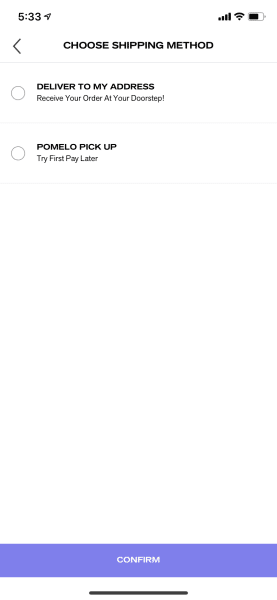
Screen Capture from the Pomelo mobile application.
They also have an ‘in-store’ mode on the app where consumers get to book a fitting room so that they don’t have to queue and instead shop around the physical store while waiting for their queue number to be called.
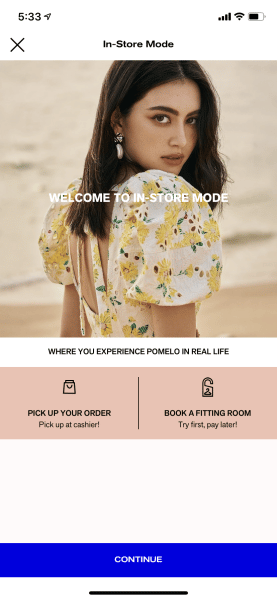
Screen Capture from the Pomelo mobile application.
This is an example of an excellent omnichannel marketing strategy where a consumer’s needs are placed first which would in turn drive sales and leads.
Case Studies: Coca-Cola
As a brand that is globally recognized for its successful marketing campaigns, Coca-Cola launched a digital media campaign in 2012 named ‘Share a Coke’ where it featured a series of bottles with names on it.
What is ‘Share a Coke’ about?
With the purpose of bringing people together and engaging their customers, 150 popular names were printed onto Coca-Cola bottles and customers got to find their names as well as their friends’ to share a drink together.
They could even share it with a stranger whose name is printed on the bottle, using it as a conversation starter.
Tactics Used
In order to get people talking about this marketing campaign, Coca-Cola mentioned the hashtag, #shareacoke, on the labels of the bottles to encourage customers to share their very own Coca-Cola bottle on social media.
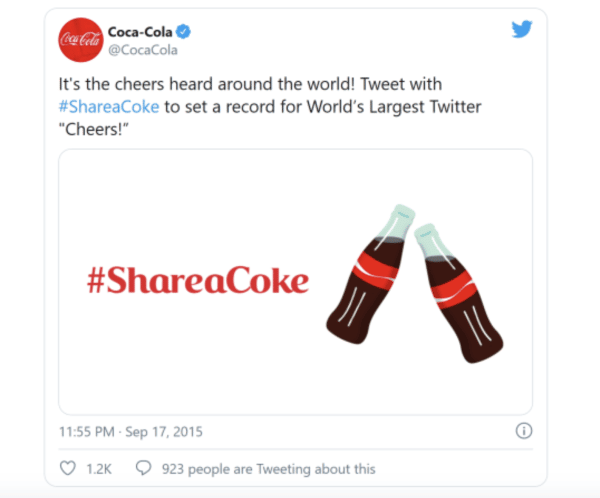
A Twitter Post about the #ShareaCoke campaign.
Sure enough, Twitter feeds started flooding with posts about the ‘Share a Coke’ campaign, and Coca-Cola also made use of multi-channels like newspapers, bus ads, television commercials, as well as social media platforms like Facebook to roll out the campaign.
Facebook was particularly successful in engaging the audience which fulfils one of the objectives of the campaign, which was to engage Coca-Cola’s customers by talking to them.
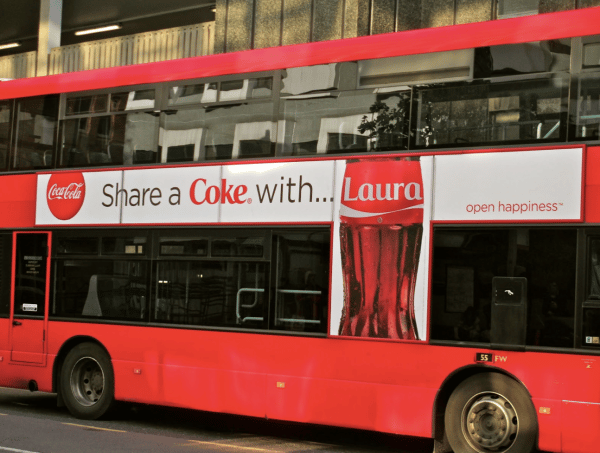
Share a Coke Campaign Ad on a bus.
Image via Digital Vidya
Another tactic used by Coca-Cola for this marketing campaign was to allow consumers to SMS their friend’s name and the name would then be displayed on the prominent Coca-Cola sign situated at Sydney’s King’s Cross.
Takeaways
Overall, this campaign has encouraged many consumers to participate and they targeted people who were very active on social media platforms as they are the people who would post on the digital platforms actively.
Case Studies: McDonalds
With stores across the globe and known as the fast-food giant, McDonald’s launched a campaign in 2013 called “Our Food. Your Questions.” in efforts to rebuild consumers’ trust by publicly answering their online questions about McDonald’s food, transparently.
How was the campaign executed?
Consumers got to submit their questions online and Mcdonald’s then broadcasted the answers around the world through the digital and traditional channels like TV and print.
As it was promoted using 500 national and international media outlets, McDonald’s garnered over 20,000 questions in just a year into their campaign.
Takeaways
This case study shows that by infusing the digital and traditional marketing tactics in the right way, one would be able to produce remarkable results in no time.
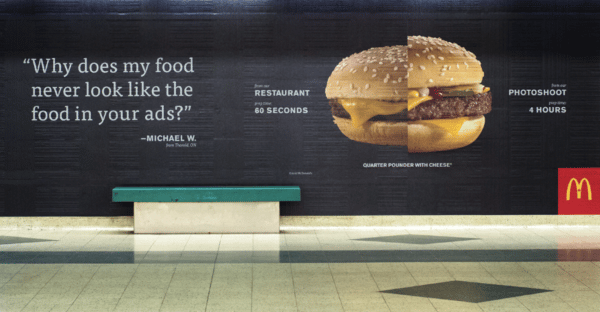
A subway ad for the “Our Food. Your Questions.” campaign.
Image via Twist & Bits
Ending Thoughts
Ultimately, it doesn’t matter which marketing method you choose to utilise because the most important thing is to find out what works best for your company and make use of that to convey your brand message and increase your conversion rates.
With that being said, both traditional and digital marketing may have its benefits and downsides but they are also excellent complements to one another. Don’t limit your creativity when integrating the two methods of marketing because it may open up endless possibilities for your business in time to come.
Ready To Learn More? Sign Up For Our Digital Marketing Strategy Course!
What we’ve just covered were just the basics of marketing.
Get ready to learn the best practices and proven methodologies to develop an effective digital marketing strategy for both B2B and B2C businesses with our Digital Marketing Strategy course.
We also host a wide range of digital marketing courses, including Digital Marketing Strategy here in Singapore and a Advanced Certificate in Digital Marketing Programme, which covers the following five modules:
- Digital Marketing Essentials
- Search Engine Optimisation
- Digital Advertising
- Social Media Marketing
- Digital Marketing Analytics with Google Analytics
Learners who complete these modules will be awarded a Advanced Certificate in Digital Marketing. Our courses are WSQ-accredited, and eligible learners can receive up to 90% subsidy.

Zhong Li is the founder of Mikangle, a digital transformation company that focuses on advisory, training, and investment. He is also the Co-founder and now Advisor of Finty, an online financial marketplace that was acquired by an Australian firm, 15 months after the company was launched.